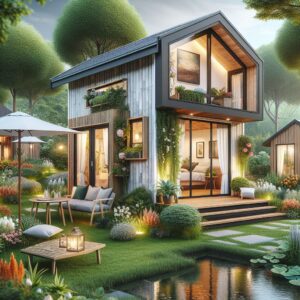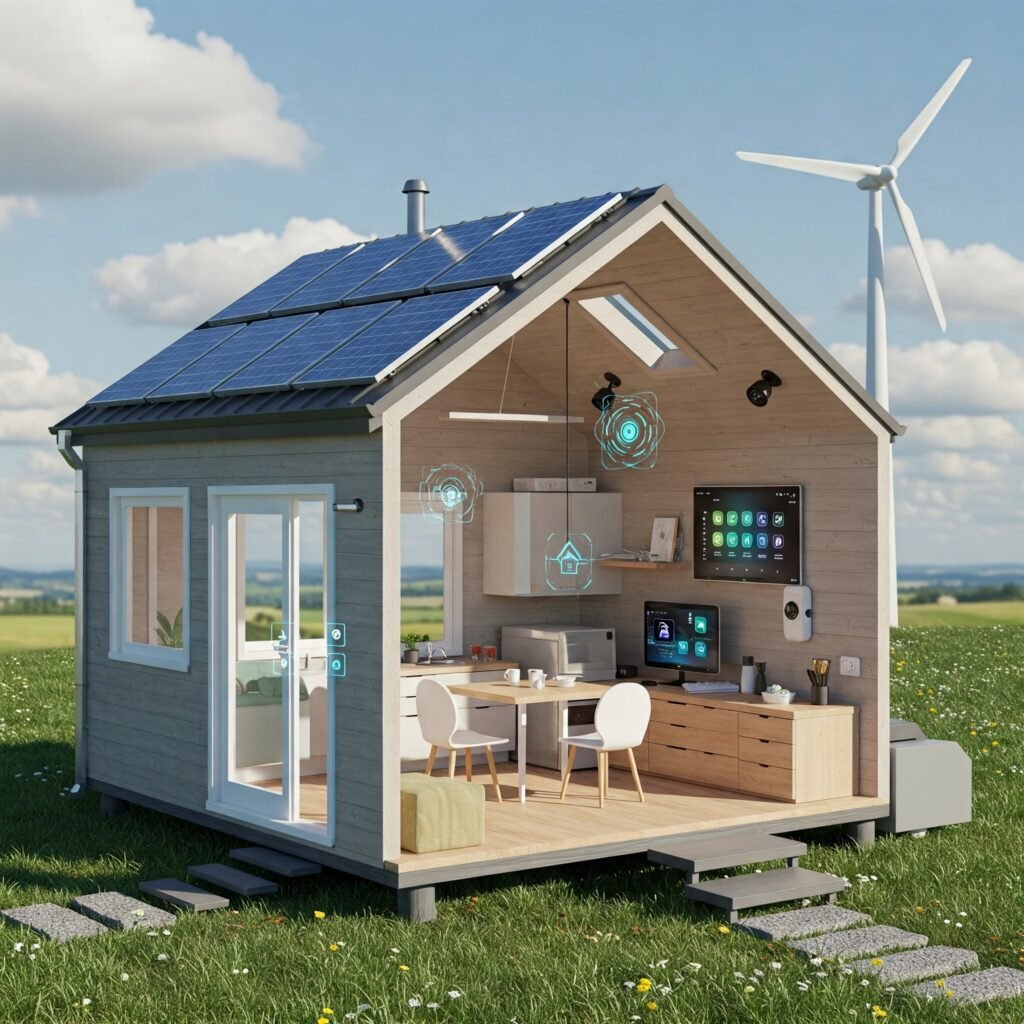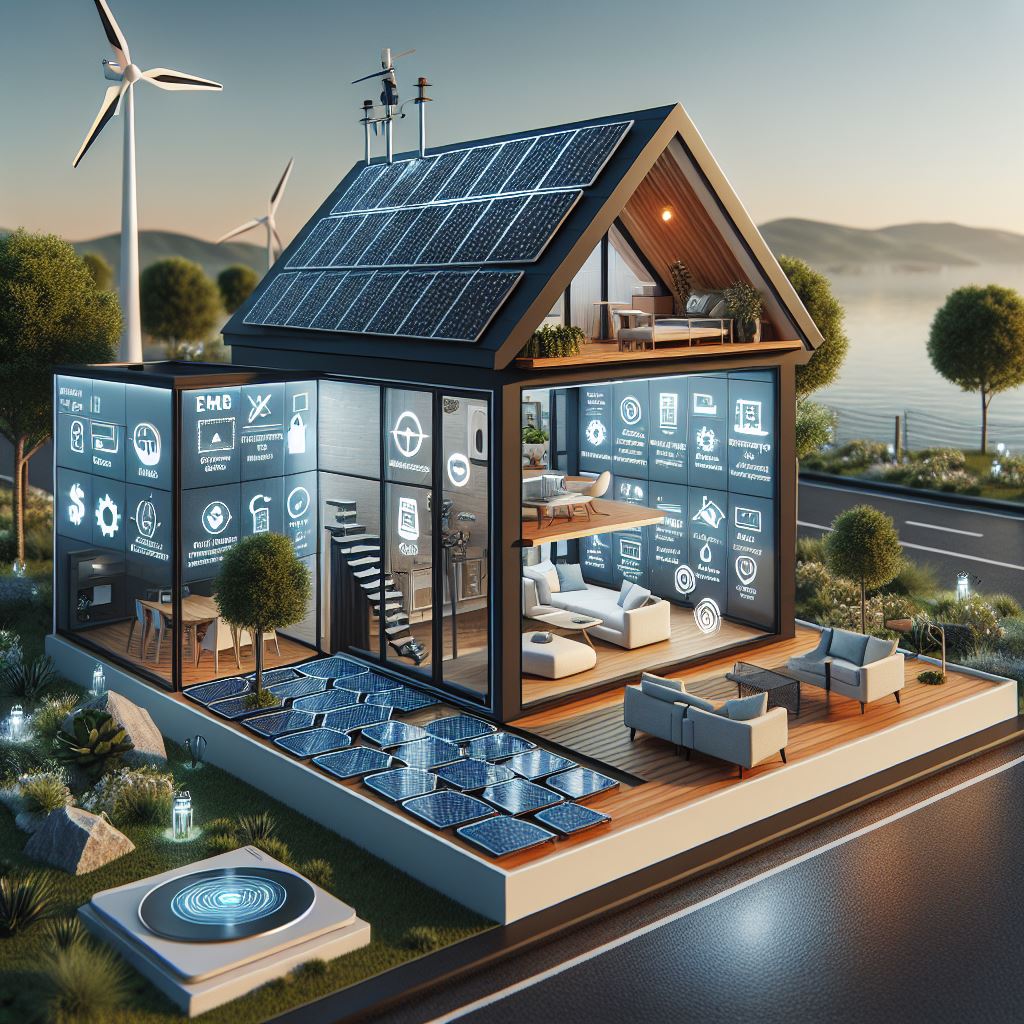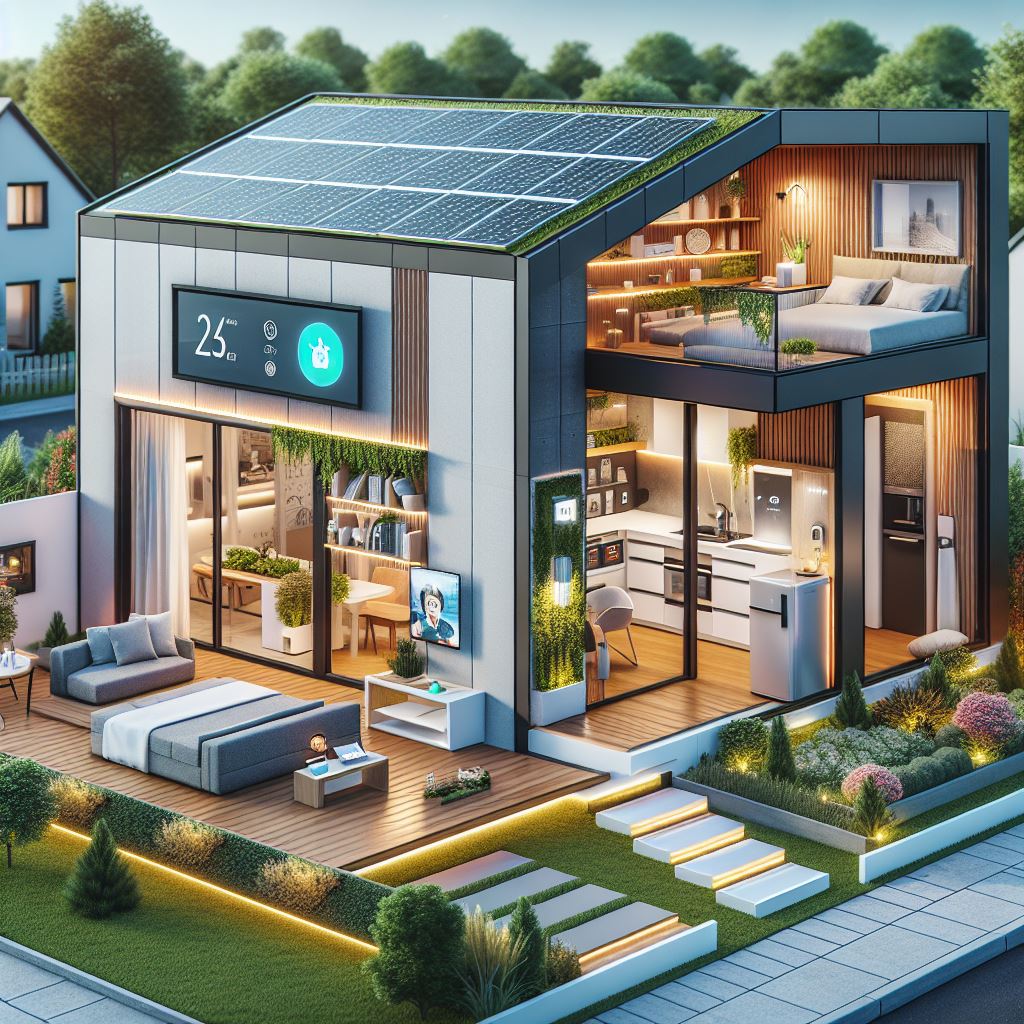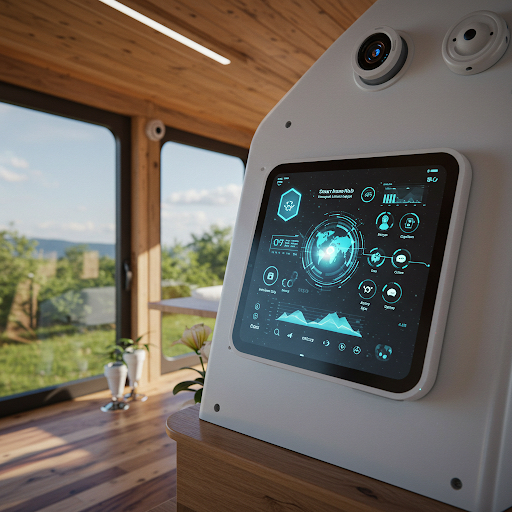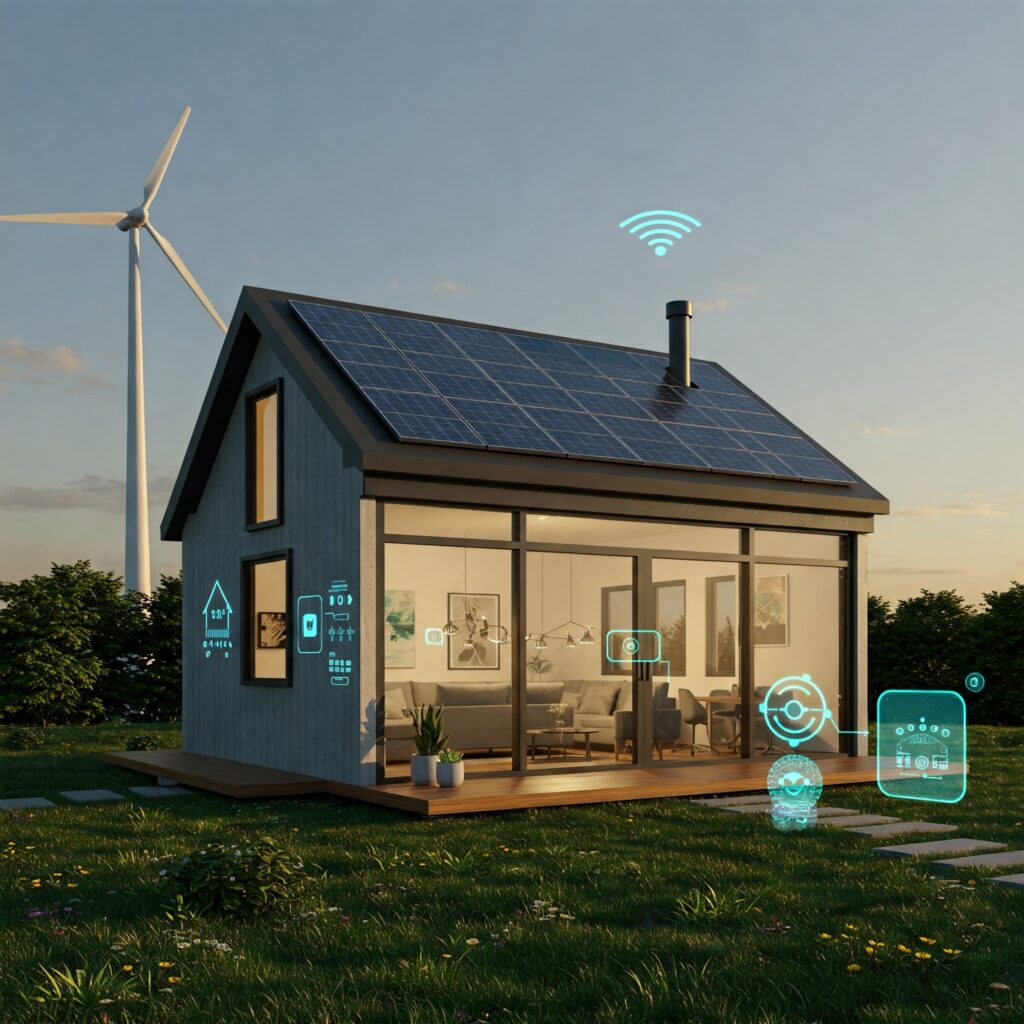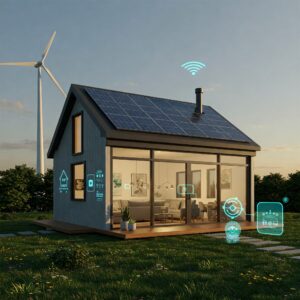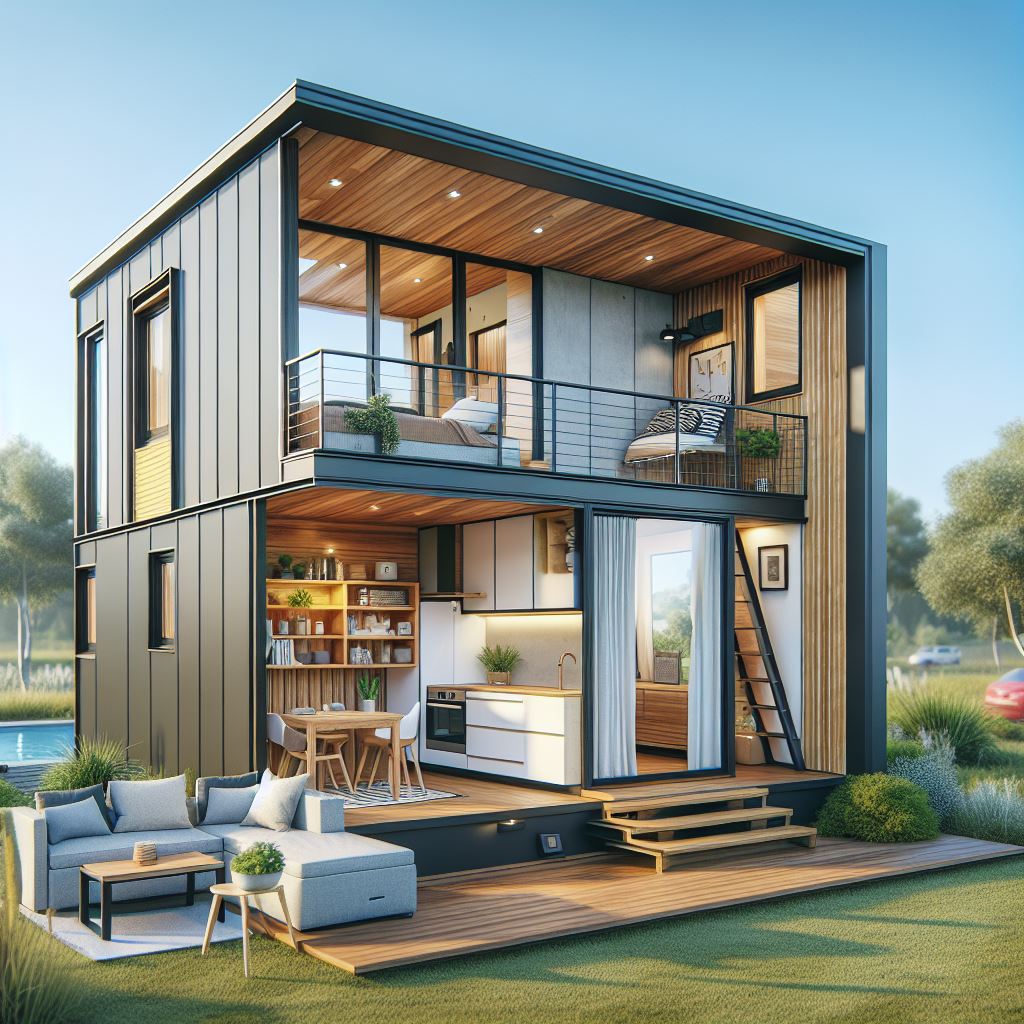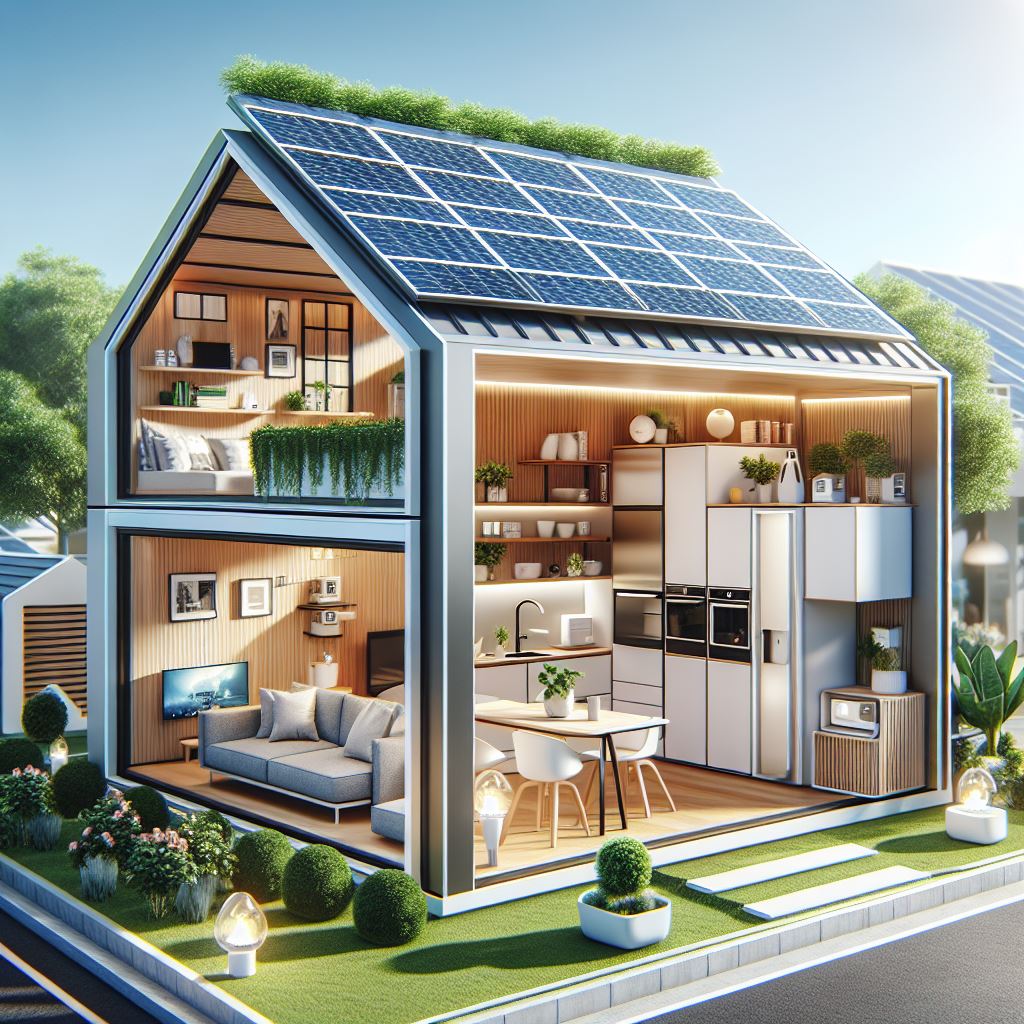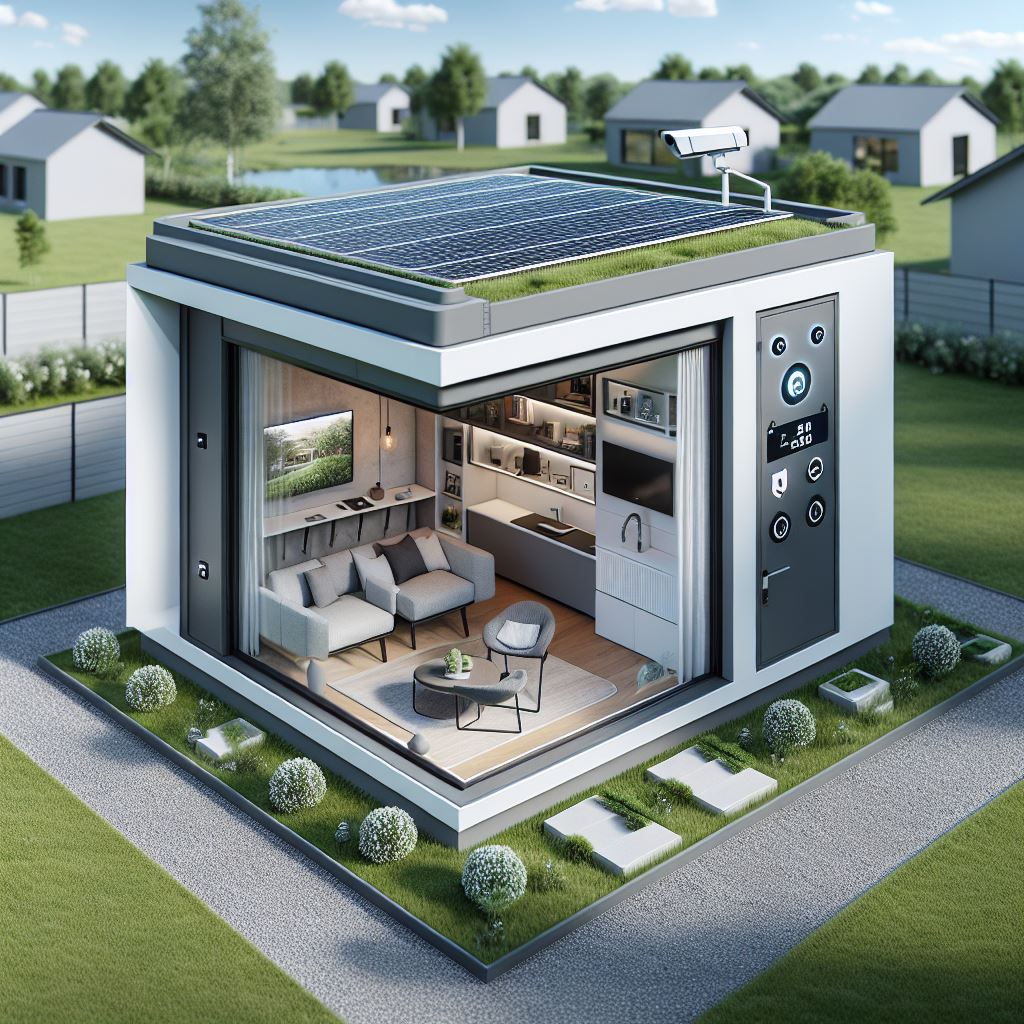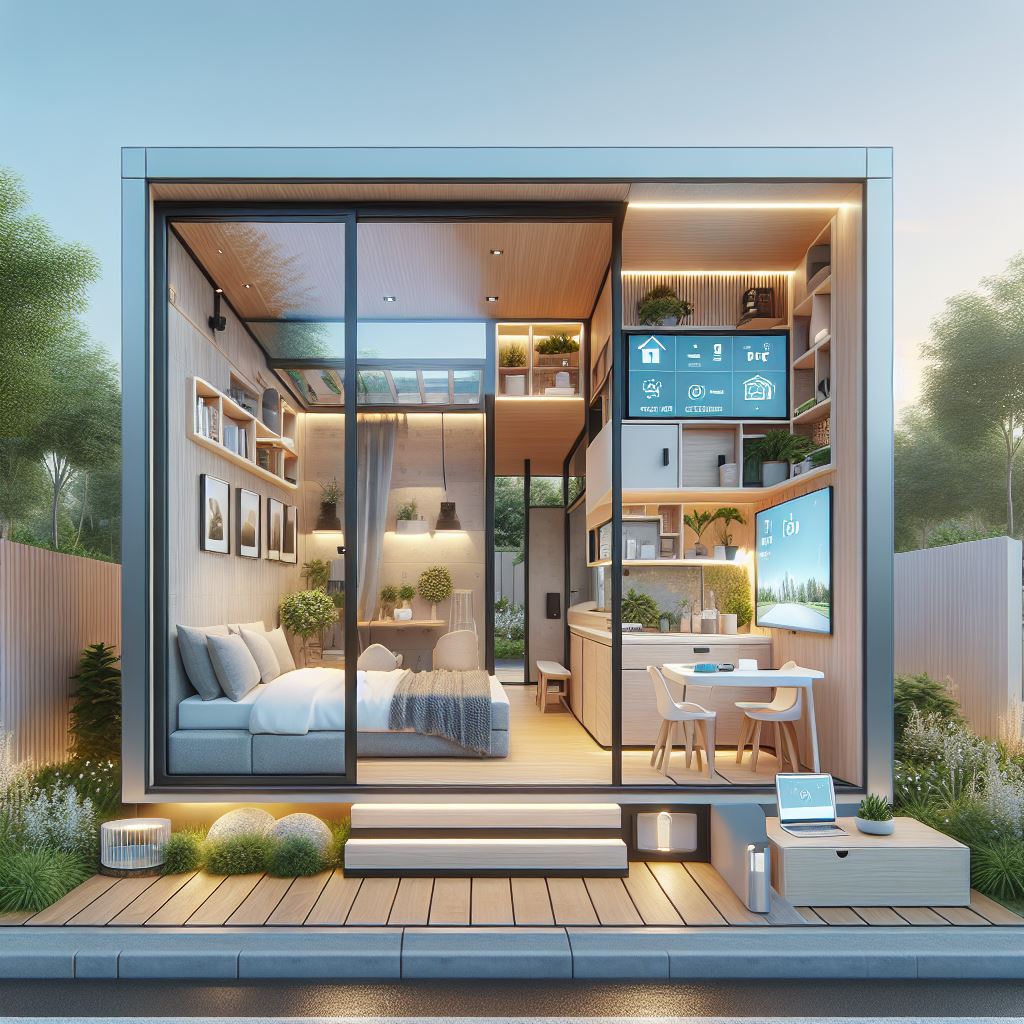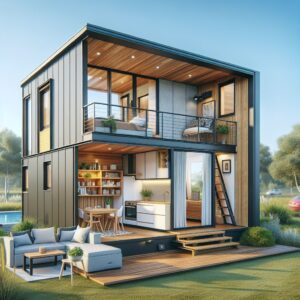This document outlines the technological vision for the “Technium” mini-house, a concept that prioritizes sustainability, self-sufficiency, and cutting-edge technology to create an eco-friendly and hyper-connected living space. We’ll cover the following:
I. Core Principles
II. Potential Challenges
III. Technology Integration
IV. Advanced Technologies – Technium Model Levels
V. Design Considerations
VI. Implementation and Future Development
VII. Conclusion
I. Core Principles:
- Sustainability: Minimize environmental impact through energy efficiency, water conservation, and the use of renewable resources.
- Self-Sufficiency: Maximize independence from external grids and services, reducing reliance on traditional utilities.
- Technology Integration: Seamlessly integrate advanced technologies for enhanced comfort, security, and user experience – LAN segmentation & WAN.
- Smart Home Automation: Automate key functions for convenience, energy optimization, and improved living standards.
II. Potential Challenges:
- Cost: The initial cost of implementing advanced technologies and sustainable building materials may be high. We’re starting around 169,995$ USD. Costs can vary based on brand/level, system size, complexity, local regulations in your area, and professional installation.
- Technical Complexity: Integrating and managing complex technologies may require specialized expertise.
- User Acceptance: Some users may be hesitant to adopt new technologies or sustainable practices.
- Regulatory Hurdles: Building codes and regulations may need to be updated to accommodate innovative housing solutions.
- Maintenance: Highly technical systems will require routine, and possibly specialized maintenance.
III. Technology Integration:
A: VOC Energy Systems
Solar Power (Panel and/or Roof):
-
- High-efficiency photovoltaic (PV) panels integrated into the roof:
- Product Example: Tesla Solar Roof (combines durable roof tiles with integrated solar cells), SunPower Equinox system (high-efficiency panels with integrated microinverters).
- Expected Cost: Tesla Solar Roof can range from $35,000 to $70,000+ for an average-sized residential roof (system size dependent). SunPower Equinox systems might cost $25,000 to $45,000+ for a comparable system size. Cost per watt for high-efficiency panels can range from $3.50 to $5.50 installed.
- High-efficiency photovoltaic (PV) panels integrated into the roof:
-
- Thin-film panels for flexible installation on curved surfaces:
- Product Example: MiaSolé FLEX-03W (lightweight and flexible), Uni-Solar PowerBond (peel-and-stick).
- Expected Cost: Thin-film panel costs can vary widely, potentially ranging from $2.50 to $4.00+ per watt installed. Installation costs might be higher due to specialized techniques. For a small house, a system might range from $5,000 to $15,000+
- Thin-film panels for flexible installation on curved surfaces:
-
- Powerwall and/or Battery storage system (e.g., lithium-ion):
- Product Example: Tesla Powerwall 3 (around 13.5 kWh capacity), LG Chem RESU10H (around 9.8 kWh capacity), Generac PWRcell.
- Expected Cost: Tesla Powerwall 3 unit itself costs around $11,500 before installation. Total installed cost can range from $14,000 to $18,000+. Other battery systems can have similar price points, ranging from $10,000 to $16,000+ installed for comparable capacities.
- Powerwall and/or Battery storage system (e.g., lithium-ion):
-
- Solar tracker system to optimize panel orientation:
- Product Example: Array Technologies DuraTrack HZ v3 (for ground-mounted systems, less common for small houses but possible), AllEarth Renewables Solar Trackers (pole-mounted options).
- Expected Cost: Solar trackers typically add a premium to the cost of a solar installation, potentially increasing the overall system cost by 20-30% or more compared to fixed-tilt systems. For a small house, this could add $5,000 to $10,000+ to the solar installation.
- Solar tracker system to optimize panel orientation:
Wind Power (optional):
-
- Small-scale wind turbine (if feasible based on location and wind conditions):
- Product Example: Primus Wind Power Air 30 (small and quiet), Bergey Excel 10 (more powerful for residential use).
- Expected Cost: Small wind turbines can range from $1,000 to $10,000+ for the turbine itself, with installation costs potentially doubling or tripling that amount depending on tower type, height, and local regulations. Feasibility and permitting in a suburban area like Centreville might be challenging. A small system might cost $5,000 to $20,000+ installed.
- Small-scale wind turbine (if feasible based on location and wind conditions):
Energy Management System (EMS):
-
- Intelligent system that monitors energy consumption, optimizes energy usage:
- Product Example: Sense Energy Monitor (plugs into the electrical panel), Neurio Wiser Energy (similar functionality), smart home hubs like Hubitat or Home Assistant with integrated energy monitoring devices.
- Expected Cost: Basic energy monitors like Sense or Neurio can cost $300 to $500 for the hardware. More comprehensive smart home EMS solutions might range from $500 to $2,000+ depending on the number of smart devices and complexity of the system.
- Intelligent system that monitors energy consumption, optimizes energy usage:
Fuel Cells:
-
- Hydrogen fuel cell system for backup power generation:
- Product Example: GenCell Energy G5rx (residential backup), PowerUP Fuel Cell Portable Power Generator (smaller scale).
- Expected Cost: Residential hydrogen fuel cell systems are currently quite expensive, potentially ranging from $15,000 to $40,000+ for the unit and installation. Hydrogen storage and refueling infrastructure for residential use is also a significant consideration and cost factor.
- Hydrogen fuel cell system for backup power generation:
Kinetic / Piezoelectric / Triboelectric Flooring:
-
- Pressurized flooring to capture the respective flooring – Walking, jumping, running, pressure, friction:
- Product Example: Pavegen (commercial applications, but conceptually similar), various research projects and prototypes exist, but widespread residential products are not yet readily available.
- Expected Cost: This technology is still in early stages for residential use and is likely to be very expensive if available at all. Costs would likely be in the tens of thousands of dollars for a whole-house installation, potentially making it impractical for most buyers currently.
- Pressurized flooring to capture the respective flooring – Walking, jumping, running, pressure, friction:
Power Backup / Generation:
-
- Traditional Generators (as an alternative/supplement):
- Product Example: Generac Guardian Series (natural gas/propane), Honda EU Series (portable gasoline).
- Expected Cost: Natural gas or propane standby generators can range from $3,000 to $10,000+ installed, depending on size and features. Portable gasoline generators can range from a few hundred to a few thousand dollars.
- Traditional Generators (as an alternative/supplement):
B. VOC Communication & Connectivity:
- LAN: Cisco Switch for Data/Voice, Security Systems, GUEST/BYOD, IoT (lighting) Connectivity & Data Storage Network Segments:
-
- Category 8 & Fiber-optic connection (roof or elevated endpoints, etc.)
- Business, Work, Streaming, Security (Perimeter & Interior Cameras, Windows, Door) Network Segmentation
-
- Enterprise Level – Network Access Control for End Devices – Posturing, Quarantine, Internet Only, etc.
- 24/7 CCTV System & Feeds/Storage, DOOR LOCKS/BADGING, etc.
- WAN: Cisco Router for High-Speed Internet and/or Line of Sight WAN:
-
- Fiber-optic connection (if available) for high-bandwidth internet access.
-
- 5G/6G cellular backup for reliable connectivity in remote locations.
- Starlink or other satellite internet options for areas with limited terrestrial connectivity.
- Wi-Fi up to 7:
-
- High-speed Wi-Fi 7 network (Router and Switch) for seamless connectivity throughout the home.
-
- Mesh Wi-Fi system to ensure strong signal coverage in all areas.
- Bluetooth up to 6.0:
-
- Bluetooth 6.0 for seamless connectivity with smart devices and peripherals.
- Home Automation Hub:
-
- Centralized hub for controlling and monitoring all smart home devices.
-
- Voice control capabilities (e.g., Apple, Amazon Alexa, Google Assistant) for hands-free operation.
- Lighting Control:
-
- Smart lighting with dimmers, color-changing capabilities, and scheduling options.
-
- Automated lighting controls based on occupancy, time of day, and ambient light levels.
- Climate Control:
-
- Smart thermostat for efficient heating and cooling.
-
- Geo-fencing technology to adjust temperature based on occupant location.
- Appliance Control:
-
- Smart appliances (refrigerators, washing machines, dryers) with remote control and energy-saving features.
- Window Treatments:
-
- Automated window shades and blinds for privacy, light control, and energy efficiency.
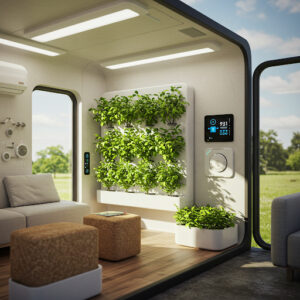
C. VOC Water Systems:
Okay, here are product examples and expected costs for the VOC Water Systems features you listed, keeping in mind that costs can vary based on brand, system size, complexity, local regulations in Centreville, Virginia, and professional installation:
Rainwater Harvesting:
- Rainwater collection system with integrated filtration and storage tanks:
- Product Example: Rain резервуар (various tank sizes and materials), Bushman Rainwater Tanks, BlueBarrel Rainwater Catchment System (DIY-friendly). Filtration systems often involve sediment filters, leaf screens, and potentially UV disinfection.
- Expected Cost: A basic rainwater harvesting system with a 500-1000 gallon tank and basic filtration might range from $1,500 to $5,000 installed. More complex systems with larger tanks (e.g., 2000+ gallons) and advanced filtration for potable water can cost $5,000 to $15,000+. Tank costs vary significantly by material (plastic, concrete, fiberglass).
- Water purification system for treating rainwater for various uses (drinking, cooking, sanitation):
- Product Example: Berkey Water Filters (gravity-fed for basic purification), UV water sterilizers (e.g., Trojan UVMax), reverse osmosis (RO) systems (e.g., APEC Water Systems). For potable water, multiple stages of filtration and disinfection are usually recommended.
- Expected Cost: A basic Berkey filter might cost $300-$500. A whole-house UV disinfection system could range from $500 to $1,500 installed. A whole-house RO system can cost $1,000 to $3,000+ installed. The specific system depends on the level of purification desired and local water quality regulations for potable rainwater.
- Smart system with soil moisture sensors to optimize water usage for landscaping:
- Product Example: Rachio Smart Sprinkler Controller, Rain Bird ST8 Smart Irrigation Timer, Hydrawise Wi-Fi Irrigation Controller. These often integrate with soil moisture sensors from brands like Rain Bird, Toro, or third-party options.
- Expected Cost: Smart sprinkler controllers range from $150 to $300 for the unit. Soil moisture sensor kits can add another $50 to $200+ depending on the number of sensors and features. Installation can range from $100 to $500+ depending on the existing irrigation system.
Greywater Recycling:
- System for collecting and treating greywater (from showers, sinks, washing machines) for use in irrigation or toilet flushing:
- Product Example: Brac Systems (more comprehensive systems), Hydraloop (all-in-one system), simpler DIY systems can be built for irrigation only (check local regulations).
- Expected Cost: Greywater recycling systems can vary significantly in cost and complexity. Simple systems for irrigation might cost $1,000 to $3,000+ for components and installation (depending on DIY vs. professional). More advanced whole-house systems like Hydraloop or Brac, suitable for toilet flushing, can range from $5,000 to $20,000+ installed. Important Note: Regulations regarding greywater recycling vary by location. It’s crucial to check the specific regulations in Centreville, Virginia, as some areas may have restrictions or require specific permits.
Water Conservation Measures:
-
- Low-flow fixtures (toilets, showerheads, faucets) to minimize water consumption:
- Product Example:
- Toilets: Toto Drake, Kohler Highline, American Standard Cadet 3 (WaterSense certified models).
- Showerheads: Speakman Reaction, High Sierra Showerheads, Delta Faucet WaterSense models.
- Faucets: Moen WaterSense, Kohler Sensate, Pfister Faucet models with low-flow aerators.
- Expected Cost: Low-flow toilets can range from $150 to $500+ per unit (plus installation if needed). Low-flow showerheads can range from $20 to $200+. Low-flow faucets can range from $50 to $300+ per unit (plus installation if needed). The cost difference compared to standard fixtures is usually not substantial.
- Product Example:
- Smart irrigation system with soil moisture sensors to optimize water usage for landscaping:
- (See product examples and costs in the Rainwater Harvesting section above.)
- Low-flow fixtures (toilets, showerheads, faucets) to minimize water consumption:
D. VOC Security Systems:
*Connectivity and Communication section above for the following devices.
Perimeter Security:
- Motion-activated lighting and cameras around the perimeter of the property:
- Product Example (Lighting): Ring Floodlight Cam Wired Plus, Philips Hue Outdoor Motion Sensor with connected lights, Arlo Pro 4 Floodlight Camera.
- Product Example (Cameras): Google Nest Cam (outdoor/indoor, battery), Arlo Ultra 2, Ring Spotlight Cam Plus, Wyze Cam v3 (budget-friendly outdoor).
- Expected Cost: Motion-activated floodlight cameras range from $100 to $300+ per unit. Standalone smart outdoor lights with motion sensors can cost $50 to $150+ per fixture (plus the cost of the lights themselves). Outdoor security cameras range from $50 for basic models to $300+ for high-end, feature-rich options. Installation costs can vary from DIY to $100-$200+ per camera if professionally installed.
- Motion sensors and vibration sensors to detect intrusions:
- Product Example (Motion): Ring Alarm Motion Detector (for indoor/outdoor use), Aqara Motion Sensor P1, Wyze Motion Sensor v2.
- Product Example (Vibration): Ring Alarm Glass Break Sensor (can detect vibrations indicative of breaking glass), Aeotec Door/Window Sensor 7 (can detect vibrations).
- Expected Cost: Individual motion sensors range from $20 to $50+. Vibration sensors (often integrated into door/window sensors) cost around $30 to $60+.
- Smart fencing with integrated sensors and security features:
- Product Example: While fully integrated “smart fencing” with widespread residential availability is still emerging, some companies offer components that can be added to existing fencing. These might include electric fencing controllers with smart features (e.g., Gallagher), or sensors that can be attached to fences (e.g., perimeter alarm systems from companies like Perimeter Technologies).
- Expected Cost: Costs for smart fencing solutions are highly variable and depend on the type of fencing, the extent of sensor integration, and professional installation. It could range from a few hundred dollars for basic sensor add-ons to several thousand dollars for more comprehensive systems. Fully integrated smart fencing designed for residential security is likely to be a premium option.
Home Security:
- Smart locks with keyless entry and remote access:
- Product Example: August Wi-Fi Smart Lock, Schlage Encode Plus Smart WiFi Deadbolt, Yale Assure Lock SL, Level Lock+.
- Expected Cost: Smart locks range from $150 to $350+ per lock. Installation can be DIY or professional, with professional installation potentially costing $50 to $150+ per lock.
- Indoor/outdoor security cameras with high-resolution imaging and night vision capabilities:
- Product Example: Google Nest Cam (outdoor/indoor, battery, 1080p or 4K), Arlo Pro 4 (2K HDR), Ring Stick Up Cam (HD), Eufy Security 2K Indoor Cam.
- Expected Cost: Indoor security cameras range from $30 to $200+. Outdoor cameras with high resolution and night vision range from $80 to $400+ per camera.
- Home security system with integrated intrusion detection, fire alarms, and carbon monoxide detectors:
- Product Example: Ring Alarm Security Kit, SimpliSafe Home Security System, ADT Smart Home Security, Vivint Smart Home Security. These systems typically include a base station, door/window sensors, motion detectors, and optional smoke/CO detectors.
- Expected Cost: DIY security system starter kits range from $200 to $500+. Professionally installed and monitored systems like ADT or Vivint often have upfront equipment costs (which can sometimes be financed or included in the monitoring fees) ranging from $100 to $1000+ and monthly monitoring fees ranging from $20 to $70+.
AI-Powered Security:
-
- AI-enabled security cameras for facial recognition, object detection, and anomaly detection:
- Product Example: Google Nest Cam (facial recognition), Arlo Ultra 2 (object detection), Eufy Security cameras (human detection, pet detection), Wyze Cam v3 with Cam Plus subscription (person/package/vehicle detection).
- Expected Cost: AI-enabled cameras often come at a premium, ranging from $150 to $400+ per camera. Some features, like facial recognition and advanced object detection, may require subscription services with monthly fees (e.g., Nest Aware, Arlo Secure, Wyze Cam Plus).
- AI-driven security systems that can learn and adapt to normal activity patterns and alert users to unusual behavior:
- Product Example: Google Nest Hub (can detect sounds like breaking glass), some higher-tier systems from companies like ADT and Vivint incorporate AI for more intelligent alerts. Standalone AI-powered security hubs are also emerging.
- Expected Cost: Systems with advanced AI capabilities can have higher upfront costs and may require professional installation and monitoring. Costs can range from $500 to $2000+ for the equipment and potentially $50+ per month for monitoring services with advanced AI features.
- AI-enabled security cameras for facial recognition, object detection, and anomaly detection:
E. Entertainment & Media (included with Network managed appliances/devices):
- Home Theater System: High-definition projector or large-screen TV with surround sound system.
- 4K/8K video streaming capabilities.
- Smart Home Entertainment System: Integrated music system with multi-room audio capabilities.
- Smart speakers for voice-controlled music playback and entertainment.
F. Health & Wellness (included with Network managed appliances/devices):
- Air Quality Monitoring: Air quality sensors to monitor indoor air quality (temperature, humidity, pollutants).
- Air purification systems to improve indoor air quality.
- Water Quality Monitoring: Water quality sensors to monitor the quality of drinking water.
- Smart Health Devices: Integration with smart health devices (fitness trackers, smartwatches) for personalized health monitoring.
G. Sustainable Building Materials:
- Eco-friendly construction materials: Utilize sustainable and locally sourced materials whenever possible (e.g., bamboo, recycled steel, reclaimed wood).
- Consider reduced waste and faster build times.
- Living Walls/Green Roofs: Integrate living walls or a green roof to improve insulation, reduce stormwater runoff, and enhance biodiversity.
IV. Advanced Technologies that will be integrated through chosen Technium Model Levels:
- Augmented Reality (AR) Integration: AR interfaces for interactive displays, personalized information overlays, and enhanced user experiences.
- Biometric Authentication: Facial recognition, fingerprint scanning, or iris scanning for secure access control.
- Robotics: Integration of small, automated robots for tasks such as cleaning, maintenance, and delivery.
- Advanced Material Science: Use of self-healing materials, smart glass, and other advanced materials for enhanced durability and functionality.
- Haptic Feedback Systems: Haptic interfaces for immersive experiences and improved user interaction with smart devices.
- Personalized AI Assistance: AI driven personal assistants that learn user preferences and provide proactive support.
- 3D Printing Capabilities: Integration of a small 3D printer for rapid prototyping, repairs, and customization.
- Soil monitoring systems: sensors to track PH, moisture, and nutrient levels for optimal gardening.
- Integrated drone port: a small landing pad with charging capabilities for personal or delivery drones.
- Smart mirror: a mirror that doubles as a display, providing information, entertainment, and health data.
- Thermal imaging: cameras and sensors that can detect heat signatures for security or energy efficiency purposes.
- AI-driven hydroponic gardening: an automated indoor gardening system that optimizes plant growth.
V. Design Considerations:
- Modular Design: Design the mini-house with modular components for easy assembly, disassembly, and expansion.
- Compact and Efficient Layout: Maximize usable space through clever design and space-saving solutions.
- Natural Light and Ventilation: Incorporate large windows and skylights to maximize natural light and ventilation.
- Accessibility: Design the mini-house to be accessible to people with disabilities.
- Aesthetic Appeal: Create a visually appealing and comfortable living space that reflects the user’s personal style.
VI. Implementation and Future Development:
- Collaborative Development: Foster collaboration between architects, engineers, designers, and technology companies to develop the Technium mini-house.
- Open-Source Platform: Consider developing an open-source platform for the Technium mini-house to encourage innovation and community contributions.
- Pilot Projects: Build and test pilot projects in various locations to evaluate the performance and feasibility of the Technium mini-house.
- Continuous Improvement: Continuously research and develop new technologies and solutions to enhance the sustainability, self-sufficiency, and user experience of the Technium mini-house.
- Scalability: Design the system in such a way that it can be scaled up or down depending on the size of the mini house.
- Remote Monitoring and Diagnostics: Implement remote monitoring and diagnostic capabilities to ensure the system’s optimal performance and to address any issues promptly.
- Cybersecurity: Prioritize cybersecurity to protect the Technium mini-house from hacking and other cyber threats.
- Integration with Smart Cities: Design the Technium mini-house to integrate with smart city infrastructure and services.
- Educational Outreach: Develop educational programs and resources to raise awareness about sustainable living and the technologies used in the Technium mini-house.
VII. Conclusion:
The Technium mini-house represents a vision for the future of sustainable and technologically advanced living. By integrating cutting-edge technologies, prioritizing sustainability, and focusing on user experience, the Technium mini-house has the potential to transform the way we live and interact with our environment. This conceptual document serves as a starting point for further development and exploration, and we encourage collaboration and innovation to bring this vision to reality.
